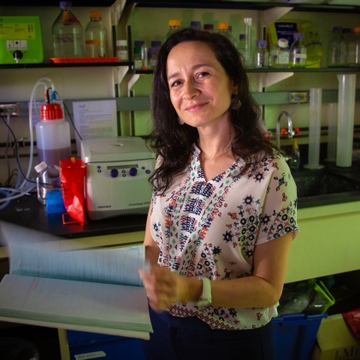Program Provides Research Opportunities for Undergraduate Students

Tracking Elusive Cancer Cells
New Grant Targets Aggressive Childhood Leukemia
T-cell acute lymphoblastic leukemia (T-ALL) - a blood cancer that primarily affects children and adolescents - has a cure rate of 85 percent or better following an initial round chemotherapy treatment.
But the picture darkens considerably for those who fail to respond to the first-line treatment or relapse. Fewer than 10 percent of those patients survive, in part because some cancerous cells have evaded the chemo by hiding out in the central nervous system.
Ksenia Matlawska-Wasowska, PhD, an assistant professor in UNM's Department of Pediatrics, has received a five-year $1.25 million grant from the National Cancer Institute to better understand this process - and potentially suggest new treatments.
In healthy people, T cells - white blood cells manufactured in the bone marrow - are among the foot soldiers in the body's defense against infections and foreign invaders. But in T-ALL, some of these cells malfunction and spread throughout the body.
"I'm interested in studying underlying mechanisms driving leukemic cells from the bone marrow to the central nervous system," Matlawska-Wasowska says. "We want to understand how they migrate there, and once they're in the central nervous system, how do they persist there, survive and become chemo-resistant."
Chemo-resistant or relapsed T-ALL is an unusually aggressive disease. "It's highly proliferative," Matlawska-Wasowska says. "That's what makes it very difficult to cure, because it's spread out all over the body."
Normally functioning T cells circulate throughout the body to find and eliminate infectious micro-organisms, she says. Matlawska-Waswoska's research focuses on a gene called SOCS5 that helps regulate how T cell migration to the brain.
Decades of leukemia research have led to a detailed understanding of what goes wrong with white blood cells in the bone marrow. "In contrast to this extensive knowledge, little is really known about the central nervous system niche," Matlawska-Wasowska says. "The ability of T-ALL cells to migrate and infiltrate the central nervous system drive down the survival rate in T-ALL."
Recent studies suggest that even after chemotherapy some malignant cells may be remain in the meninges, the tough layers of tissue surrounding the brain and spinal cord. "I believe there are always a small number of cells that are literally hiding there," she says.
"Another important question is, at what point do these cells decide to come back?" Matlawska-Wasowska says. "What is so unique about the meninges? What growth factors are secreted by the cells residing in the central nervous system that support their survival?"
Matlawska-Wasowska, who received her PhD from the University of Lodz in her native Poland, first came to UNM in 2009 as a postdoctoral researcher, then signed on as research faculty for two years before becoming a tenure-track assistant professor in 2014.
Matlawska-Wasowska hopes that her research into the SOCS5 gene funded by the new grant will help identify other steps in the process of migrating T cells that could be targeted by new or existing drugs.